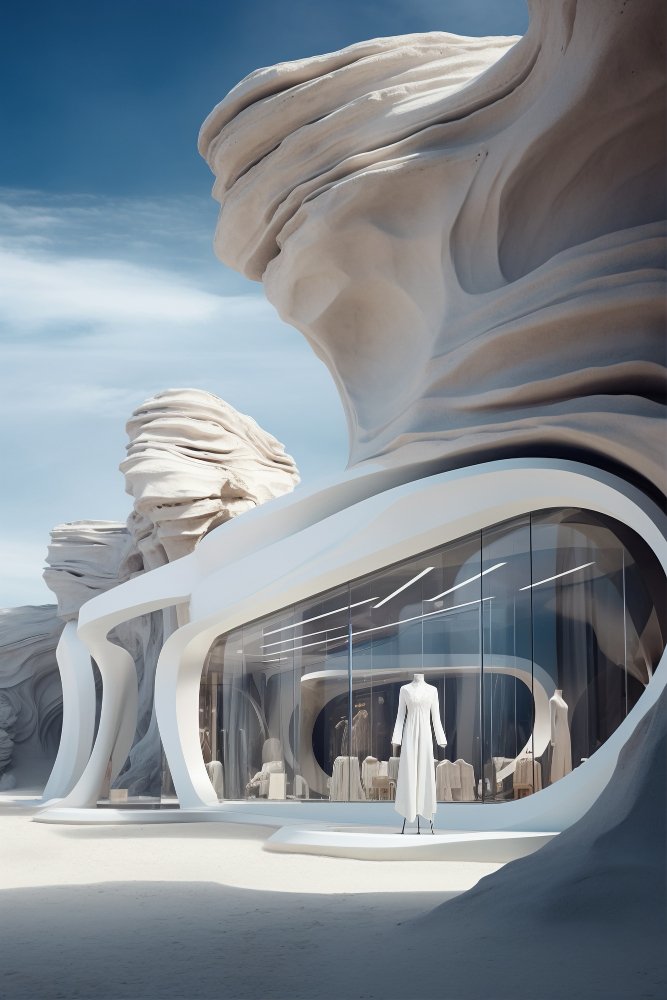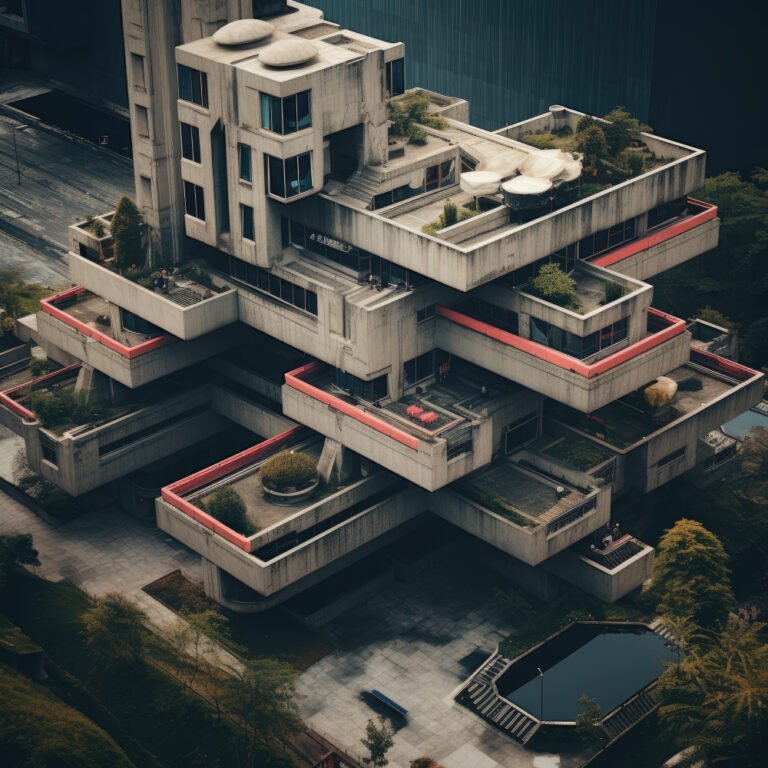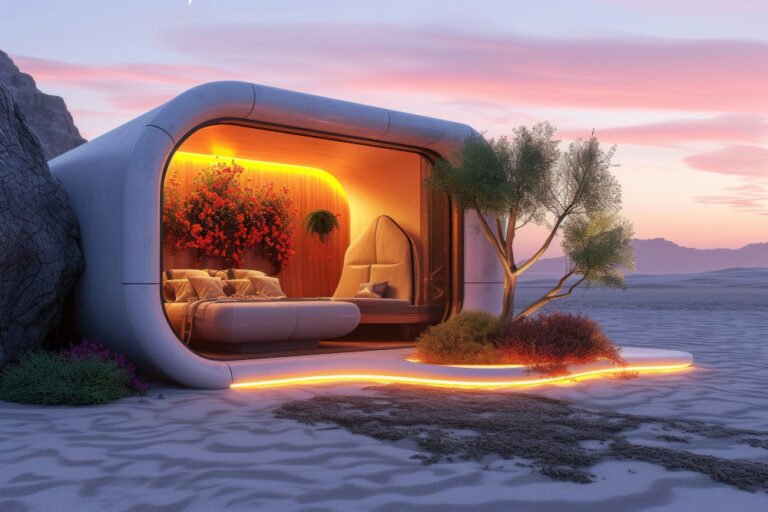Space Architecture: 5 Futuristic Designs You Must See

Space architecture is where engineering, imagination, and survival science collide — it’s designing buildings for environments that don’t care about human comfort. From pressurized inflatable rooms that “pop” into life in orbit to robot-printed igloos on Mars and vast rotating cities the size of small countries, these concepts show how we’ll turn vacuum, vacuum-cold, and regolith into places where people can live, work, play, and grow food. Below are five futuristic space-architecture designs that are technically interesting, visually striking, and — crucially — represent different pragmatic strategies for solving the same set of problems: radiation, mass-to-orbit limits, thermal extremes, life-support integration, and resilience.

Table of Contents
1) Inflatable & Expandable Habitats — big interior, small launch volume
Why this idea matters
Inflatable (a.k.a. expandable) modules compress into a small rocket fairing, then inflate into a much larger habitable volume in space or on another world. For missions where launch mass and volume are premium, expandables give a disproportionately large interior per kilogram — a powerful lever when living area and crew psychology matter.
How they work (and why they’re credible)
The basic pattern is simple: a rigid core for docking/airlock interfaces + a folded multi-layer fabric shell that inflates and locks into shape. Layers provide micrometeoroid protection, thermal insulation, and puncture resistance; internal thin frames or tension geometry handle pressure loads. This approach was flight-tested on the ISS with the Bigelow Expandable Activity Module (BEAM), validating that the concept works in real orbital conditions. NASA
Where this design shines
- Low volume-to-internal-space ratio (ideal for habitats, labs, greenhouse modules).
- Lower launch cost per cubic meter than equivalent rigid modules.
- Easier to transport multiple modules and expand a base incrementally.
Practical limits & engineering pitfalls
- Fabric systems are damage-tolerant but not invulnerable — redundancy and repair strategies are essential.
- Thermal control and micrometeoroid shielding require multiple layers and potential hardening.
- For surface use (Moon/Mars) expandables are typically combined with local shielding (buried under regolith or integrated with rigid shells).
Tip for architects: design the interior for human habitability first (lighting, circulation, psychological cues) and let the inflatable shell follow — retrofit scale and panelization matter when you can’t easily change the shell once deployed.
2) Regolith 3D-Printed Shells — SinterHab & Project Olympus (print what’s under your boots)
Why this idea matters
Mass is expensive. The more you can build from local materials, the less you must haul from Earth. Regolith (the dusty rock of the Moon and Mars) is abundant — but tricky to work with. The clever idea behind SinterHab and Industry projects like ICON’s Project Olympus is to use robots and additive manufacturing to turn local dust into structural shells: sintered, layered, or melted into bricks and arches that shield crews from radiation and micrometeoroids.
What “SinterHab” and Project Olympus bring to the table
SinterHab (a design study originally linked with International Space University and NASA collaborations) explores hybrid habitats: deployable interiors (membrane bladders, prefabricated nodes) protected by a thick sintered regolith shell produced by robots on site. ICON’s Project Olympus — backed by a significant NASA SBIR/contract award — is actively developing surface 3D-printing hardware and workflows intended to build habitats using lunar and Martian materials. These efforts indicate the idea is moving from paper to demonstrator stages. SpaceArchitect.org | SpaceArchitect.org
Where this design shines
- Excellent radiation & thermal protection because regolith is mass.
- Uses local feedstock: long-term cost benefits and scale potential.
- Robust, low-maintenance outer skin — good for permanent bases.
Practical limits & engineering pitfalls
- Robotics and printing reliability in abrasive dust is a major challenge.
- Material properties (porosity, thermal cycling durability) must be validated at scale.
- Initial robotic assets still need to be delivered from Earth — so early settlements are hybrid (imported systems + local shells).
Tip for architects: favor modular interior shells that allow the regolith skin to be built in stages; plan logistics for dust mitigation, robotic maintenance corridors, and thermal expansion joints.
3) Mars Ice House & Ice-Printed Habitats — water as structure, shield, and light
Why this idea matters
On Mars, water ice is not just life’s supply — it’s a compelling construction material. The Mars Ice House concept (winner of NASA’s 3D-Printed Habitat Challenge in its early phases) proposes using local water ice to print translucent, layered shells. Ice offers both radiation shielding and the psychological benefit of letting diffused light through — a huge morale boost in remote, enclosed environments. Melodie Yashar
How ice printing could work
Robots collect and process local ice or bury water, then deposit and freeze layers around an inflatable or scaffold core. Aerogel or ETFE membranes are often used inside to retain pressure while the ice shell forms the thermal and radiation barrier. Ice is structurally competent in the cold Martian environment, and its translucency preserves a softer “daylight” quality inside.
Where this design shines
- Uses a locally abundant resource (in some regions of Mars) to produce mass shielding.
- Translucency supports circadian rhythm and better interior lighting without huge energy demands.
- Ice is repairable (melting + refreeze) and could be refilled or thickened over time.
Practical limits & engineering pitfalls
- Not all landing sites have accessible ice — site selection is limiting.
- Structural concerns for ice under thermal gradients, micrometeoroid impact, and sublimation must be engineered carefully.
- Autonomous additive processes must work reliably in dusty, cold, and windy conditions.
Tip for architects: integrate ice shells with interior life-support so the ice also serves as water storage and emergency reserves — design redundancy into the thermal balance to prevent slow sublimation.
4) Lava-Tube & Subsurface Conversions — use nature’s bunker
Why this idea matters
On the Moon (and possibly on Mars), nature already created highly useful shelters: lava tubes — long subterranean voids formed by ancient volcanic flows. These tunnels can be hundreds of meters across and immediately provide radiation shielding, thermal stability, and micrometeoroid protection. Converting lava tubes into habitats is one of the most mass-efficient ways to achieve high levels of protection with minimal transported material.
What research says
Recent scientific assessments and reviews show lunar lava tubes are real candidates for bases: surveys of LRO data, radar mapping, and studies published as recently as 2024 reinforce that large, structurally sound tubes likely exist and could shelter a future base. Using a lava tube avoids the need to print or ship meters of shielding to protect crews. ScienceDirect
Where this design shines
- Immediate, massive radiation and thermal protection.
- Lower construction mass (you don’t need to create the overburden).
- Interior systems can be simpler: less thermal cycling, fewer heavy insulation demands.
Practical limits & engineering pitfalls
- Finding, characterizing, and safely entering accessible tubes is nontrivial — reconnaissance rovers and probes are needed.
- Access (skylights) may require building elevators, ramps, or pressurized lifts.
- Rockfall, seismic stability, and dust mobilization need robust engineering analysis.
Tip for architects: plan the conversion as layered: first robotic scouts and stabilization; then modular inflatable or rigid interiors; then long-term growth corridors with utility tunnels and greenhouses linked by pressurized connectors.
5) Rotating Space Settlements — O’Neill cylinders & Stanford torus (the wow factor)
Why this idea matters
If you scale up beyond planetary surfaces, space architecture changes into urban design in microgravity: rotating habitats such as O’Neill cylinders and the Stanford torus create artificial gravity by rotation and offer a way to build truly large, Earth-like environments in orbit. These are not near-term Moon base tactics — they are civilization-scale proposals — but they define the ultimate endpoint of space architecture: habitats that can support thousands to millions with agriculture, even weather, inside engineered shells. Wikipedia
What these designs promise
- Continuous artificial gravity at the inner rim, enabling Earth-like living and large-scale agriculture.
- Vast internal land area for cities, parks, and industry — not just survival modules.
- Use of off-Earth materials (asteroids, lunar regolith launched by mass drivers) to reduce Earth launch mass.
Practical limits & engineering pitfalls
- Immense initial capital and materials; infrastructure depends on in-space manufacturing and resource extraction at scale.
- Long lead times for construction, complex dynamic stability issues (counter-rotating cylinders to cancel gyroscopic effects).
- Political, economic, and safety frameworks for multi-kilometer structures remain speculative.
Tip for architects: treat rotating habitats as integrated systems: urban planners, life-support engineers, and material scientists must collaborate from concept phase — these are urban machines as much as they are buildings.
Comparison Table — pick your strategy
| Design | Best for | Key advantage | Show-stopper / Risk |
|---|---|---|---|
| Inflatable / Expandables (BEAM etc.) | Orbital & early surface habitats | High interior volume per launch mass. | Exterior puncture / dust wear; needs shielding. NASA |
| Regolith 3D-print shells (SinterHab, Project Olympus) | Permanent bases on Moon/Mars | Local materials = lower long-term mass. | Robotic reliability; material durability. SpaceArchitect.org | SpaceArchitect.org |
| Ice-printed habitats (Mars Ice House) | Polar or ice-rich Martian sites | Water = structure + shield + light. | Site limited; thermal stability & sublimation. Melodie Yashar |
| Lava-tube conversions | Moon/Mars sites with tubes | Natural shielding & stable thermal environment. | Site scouting, access engineering. ScienceDirect |
| Rotating settlements (O’Neill) | Long-term off-Earth civilization | Artificial gravity, huge internal land area. | Materials + politics + economics at scale. Wikipedia |
Design lessons from the five concepts (practical tips & tricks)
- Design for layered resilience. Combine passive mass shielding (regolith/ice) with active systems (radiation forecasting, safe rooms). Don’t assume any single approach is sufficient.
- Make interiors human first. Interiors need daylight cues, private spaces, and varied scales — psychological design is mission-critical.
- Robots build before humans. The safest path is heavy robotic pre-deployment: power plants, ISRU pilot plants, and the outer shell should be ready before crew arrival.
- Standardize interfaces. Universal docking, utility connectors, and module dimensions reduce logistics friction and allow multi-vendor ecosystem growth.
- Plan for maintenance and repairability. Dust, thermal cycling, micro-impacts — these are persistent issues. Make patches, spares, and robotic repair kits part of the baseline architecture.
- Think in systems, not objects. A habitat is not a house — it’s a life-support machine integrated with power, water, waste, comms, and logistics.
Related links & sources (read more)
- BEAM (Bigelow Expandable Activity Module) — NASA info & BEAM background. NASA
- SinterHab / 3D-printed lunar habitat design studies. SpaceArchitect.org | SpaceArchitect.org
- Project Olympus / ICON lunar construction contract (NASA SBIR). NASA
- Mars Ice House — SEArch + Clouds AO winning design & writeups. Melodie Yashar
- Lunar lava tube review & candidate shelter studies. ScienceDirect
- O’Neill cylinder overview and historical NASA/Stanford studies. Wikipedia
FAQs (6)
Q1 — Which of these designs will be used first?
Inflatables and surface modules combined with local regolith shielding are the most likely early approach. BEAM-style expansion has already flown in orbit and surface inflatable + buried concepts are pragmatic early picks. NASA
Q2 — Are 3D-printed regolith habitats realistic or still science fiction?
They’re realistic in concept and in active development. Multiple demonstrator projects (SinterHab, ICON’s Project Olympus, winners of NASA’s 3D-Printed Habitat Challenge like AI SpaceFactory’s MARSHA) show the technology path is advancing from concept to prototype. SpaceArchitect.org | SpaceArchitect.org
Q3 — Can ice really be used as a structural material?
Yes — in very cold environments ice behaves like a solid structural material. The Mars Ice House concept uses ice layer printing to form a durable shell that also provides radiation shielding and light diffusion; site selection (accessible ice) is the main constraint. Melodie Yashar
Q4 — If lava tubes are so good, why not only use them?
Lava tubes are excellent but rare and unevenly distributed relative to mission targets; they require careful geological confirmation and safe access systems. They’re likely to be a preferred site where available, but not a universal solution. ScienceDirect
Q5 — Are O’Neill cylinders ever going to be built?
They’re conceptually sound but require huge in-space manufacturing and resource extraction capabilities (asteroid mining, lunar mass drivers) plus massive capital and decades of development. Expect them far down the timeline — they’re the “City on the Moon” vision rather than this-decade hardware. Wikipedia
Q6 — How should architects get started in space architecture?
Learn the constraints (mass, radiation, thermal cycles, dust), study existing demonstrators (BEAM, NASA 3D-Printed Habitat Challenge winners), and collaborate with robotics and materials engineers. Start with modular, maintainable designs and prioritize human factors.
Conclusion — Design for people, build with robots, protect with mass
These five designs represent distinct strategies for turning hostile planetary and orbital environments into livable places. Inflatable modules buy interior volume today; 3D-printed regolith shells and ice houses cut the mass penalty by using local resources; lava tubes offer nature’s shielding; and rotating megastructures sketch the civilization-scale endpoint. Across all options the recurring pattern is the same: use robotics to build, use local resources to shield and scale, and design interiors for human psychological and social needs. Space architecture is not an aesthetic exercise; it’s the art and science of survival — and it’s getting real fast.






